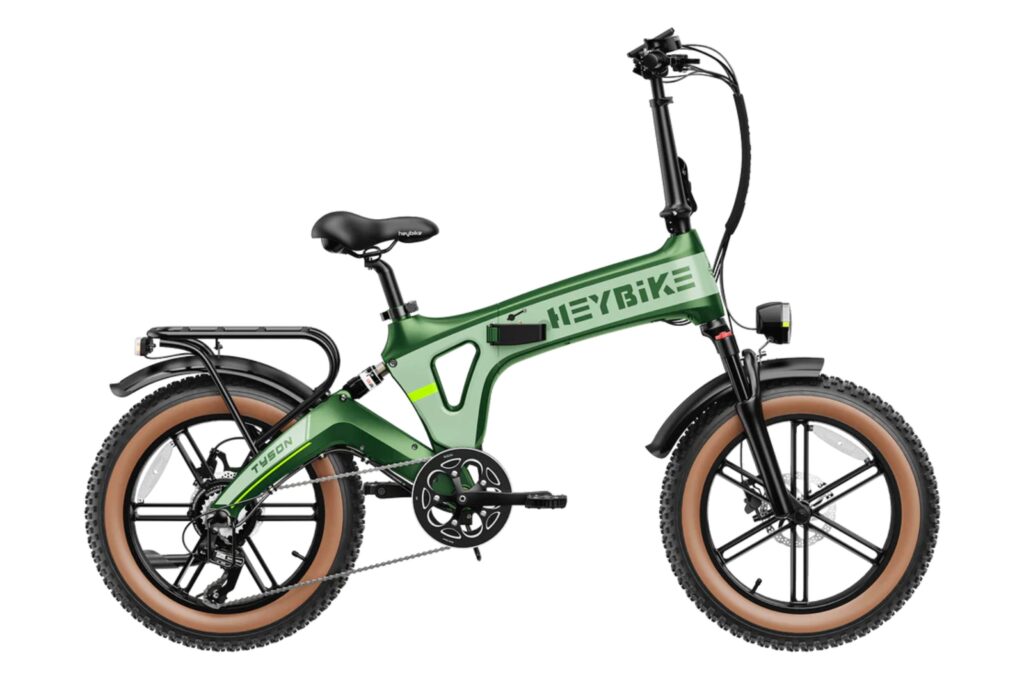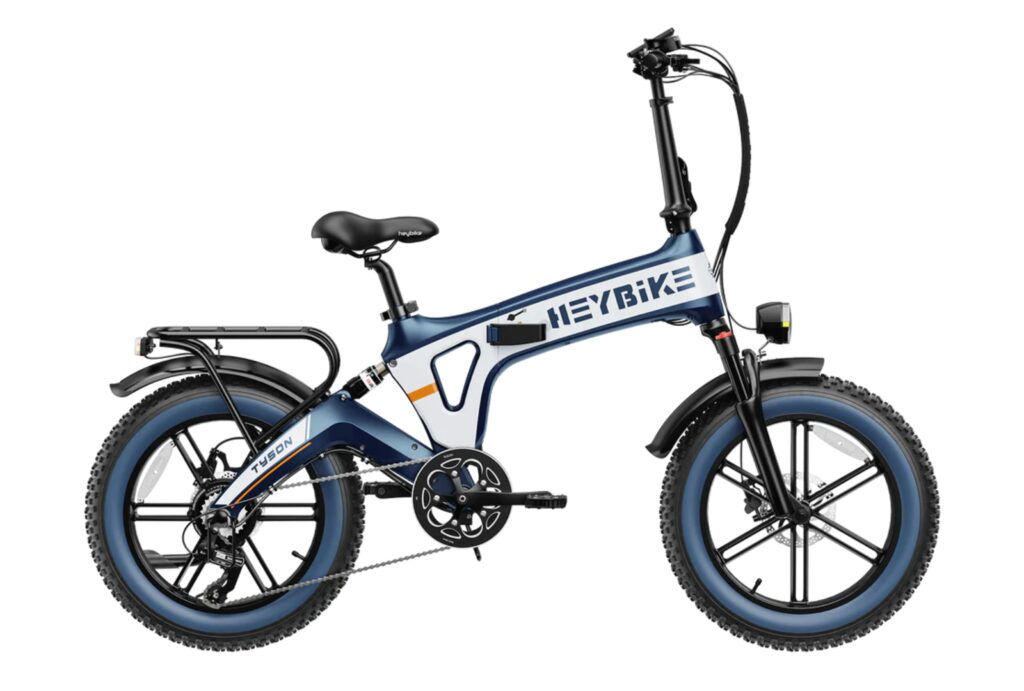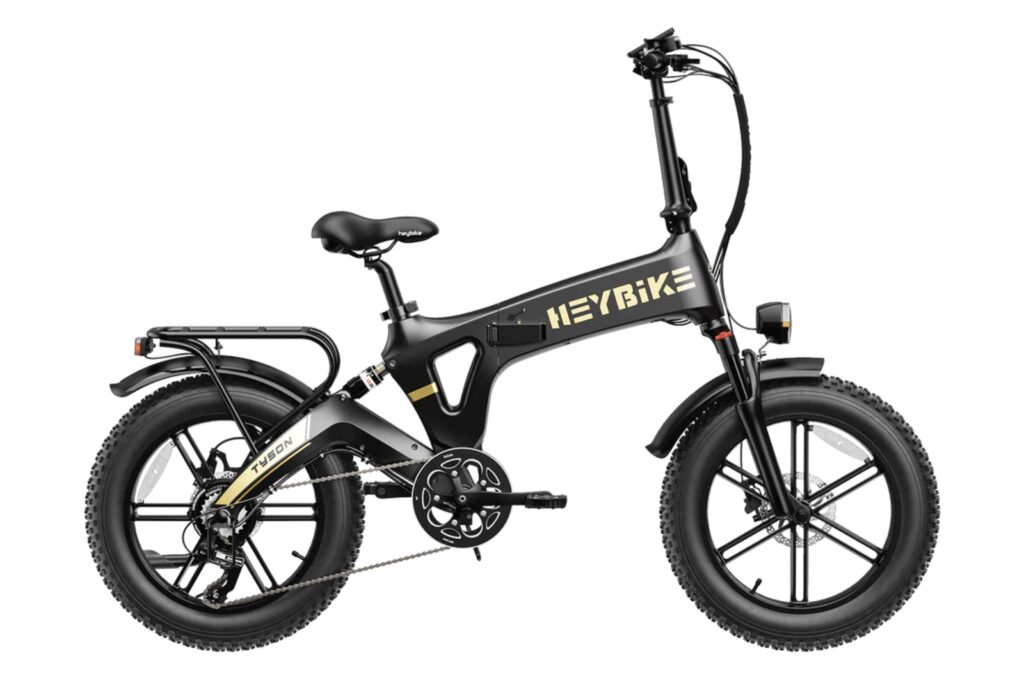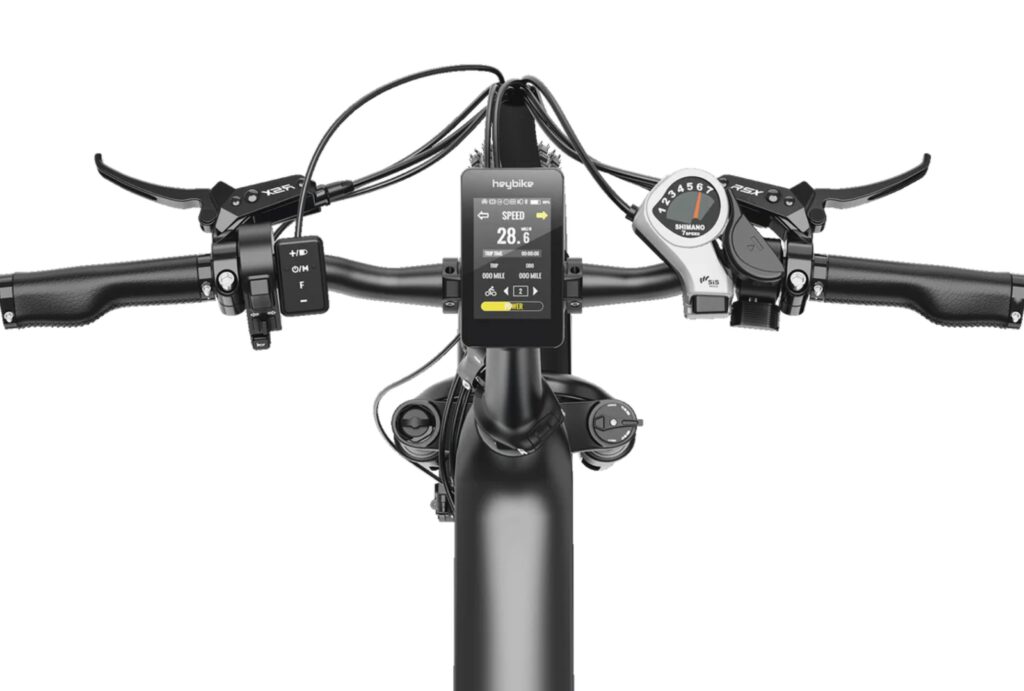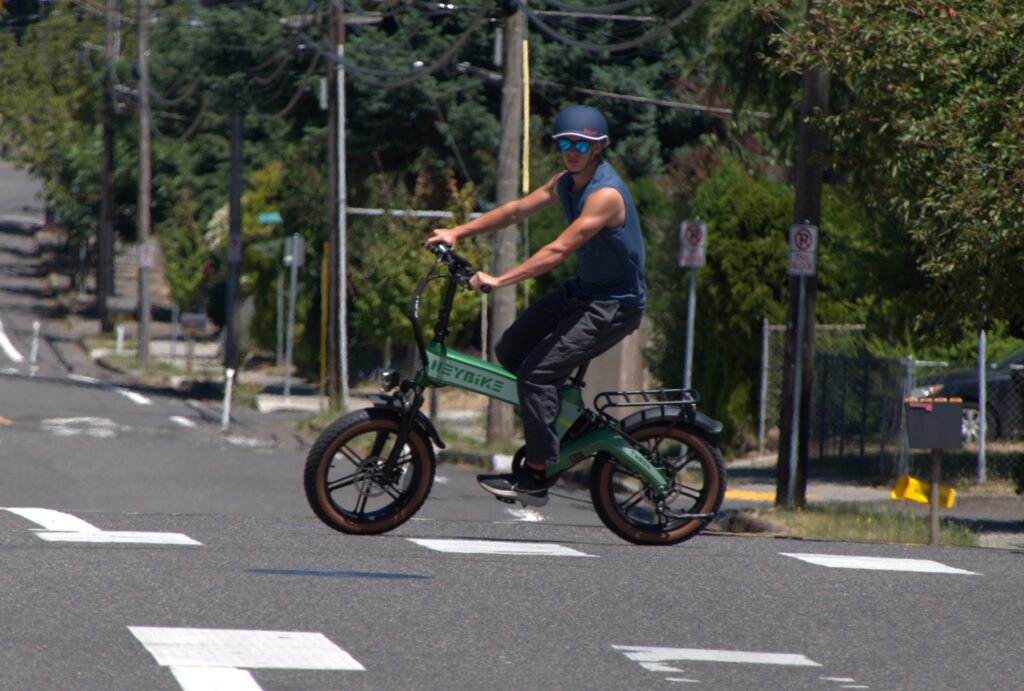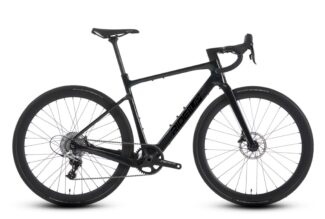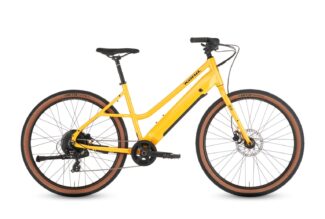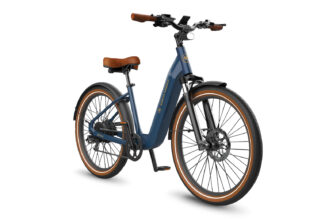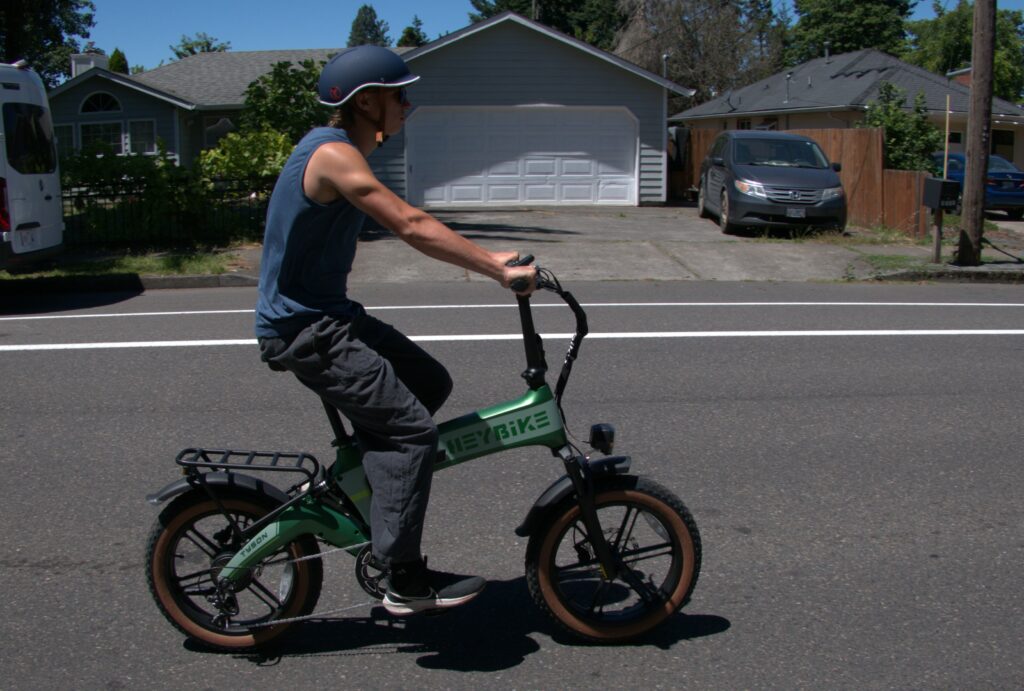
Shipping and Assembly
My fern green Heybike Tyson arrived inside a small-ish bike box in typical direct-to-consumer form. Assembly was straightforward since Heybike included the essential tools needed to complete the bike and get it ready to ride.
I simply pulled it out of the box, unfolded it, and attached the front wheel and seat using the included tools. Next, I aired up the tires, double-checked the folding mechanism’s clamp and the hex bolts for tightness, and powered up the bike. The setup took about 20 minutes, which is about the average assembly time for e-bikes that arrive about 90% complete.
It’s worth noting, though, that I didn’t ride it right away. Instead, I let the battery charge overnight. After downloading the app and connecting to the bike via Bluetooth, I tweaked a few settings, and it was ready to ride.
Most anyone who can use an Allen wrench and screwdriver can get the Tyson ready to ride within 30 minutes, but if in doubt, most bike shops can make sure everything is to spec for a small charge.
Apps and Connectivity
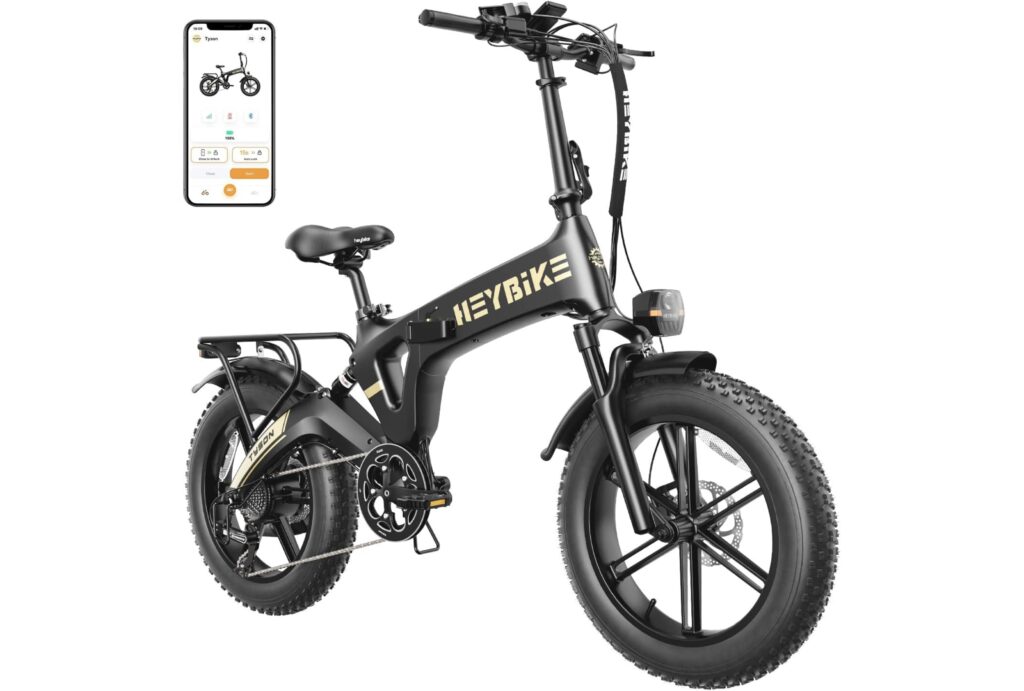
Heybike has built a robust app — simply called ‘Heybike’ — that’s free for both Apple and Android devices.
It allows users to tweak the bike’s performance settings, get alerts if a problem arises, track the bike’s location using 4G cellular technology, record ride data, and even permit remote unlocking. The app also enables sharing on social platforms, in-app GPS routes, and regular updates.
How the Heybike Tyson Performed
Overall, the Heybike Tyson offers good value for the price, and we had no trouble with it during the testing period.
They Heybike Tyson’s Fit and Feel
As a large-sized rider (6’1”, 230 lbs), I’m usually at the outside limit of the seat/bar/pedal triangle on foldies. However, the Heybike Tyson was a pleasant surprise. It was larger than most other folding bikes I’ve ridden, making it an unexpectedly comfortable e-bike.
I usually tweak the seat and bar position to my liking on any bike I review. For the Tyson, I only needed to move the seat back a bit for my 34” inseam. Handlebar adjustability is minimal on the Tyson, though.
Pedal Assist Levels
I first rode the Tyson with the tires close to maximum pressure and the bike’s systems set to Level Zero (no assist). In this ‘analog mode’, riding the Tyson was easy — at least in the flat. But when I came to a grade of almost any sort, the Tyson’s 77 lbs quickly became apparent.
The Shimano 7-speed shifter gears down low enough to surmount gentle grades with some seated pedaling, but it doesn’t result in much speed. That means you could technically pedal home (no motor assist) if you get stuck with a dead battery — unless, of course, you live at the top of a steep hill.
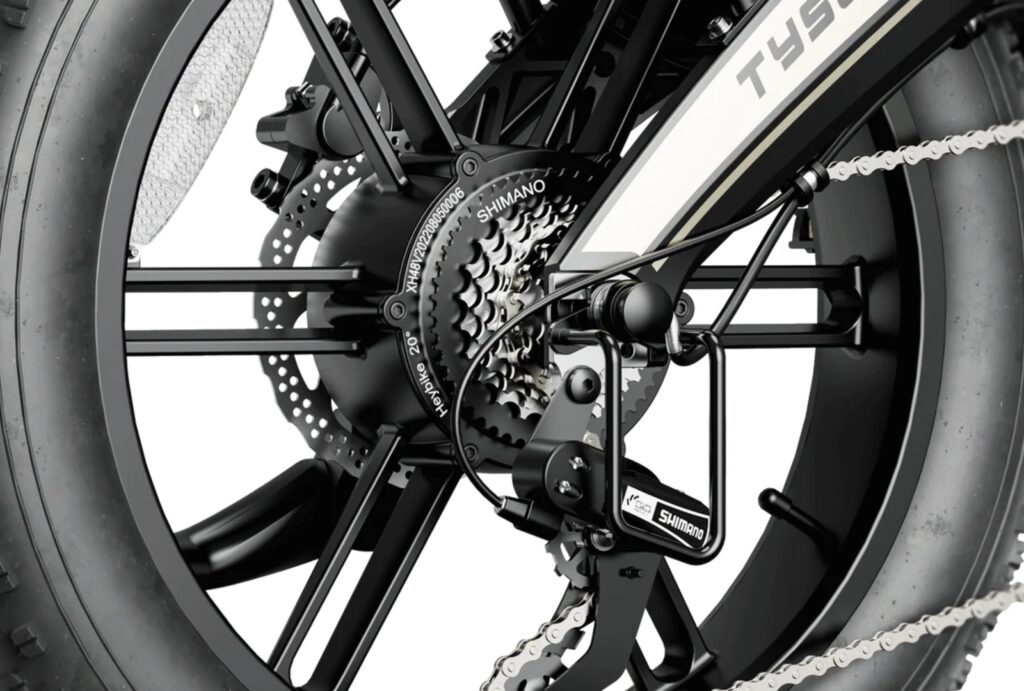
Key in assist at Level 1, and the Tyson gently surges ahead as you turn the pedals or nudge the thumb throttle. Under power, the Tyson sheds its weight and spins up to 20 mph quickly when set above the lowest assist level.
I pushed the PAS up to the maximum level on my hill test, and it performed nicely. I set assist at Level 5 and headed up the hill at an impressive pace, close to 15 mph in most sections.
Motor and High-Speed Performance
With a 1,400 W peak output, nearly double the motor’s nominal 750 W power rating, the Tyson has brisk acceleration above the lowest power setting. It can hit 28 mph easily, thanks, in part, to the tall gearing of the main front sprocket. Without pedaling, the top speed on the throttle is 20 mph.
After climbing an urban hill I use for testing assist power (see my hill test below), I blasted down the grade on a different road. Brushing up against 40 mph on the pockmarked and well-worn pavement is asking a lot from a folding bike with 20” wheels and knobby tires.
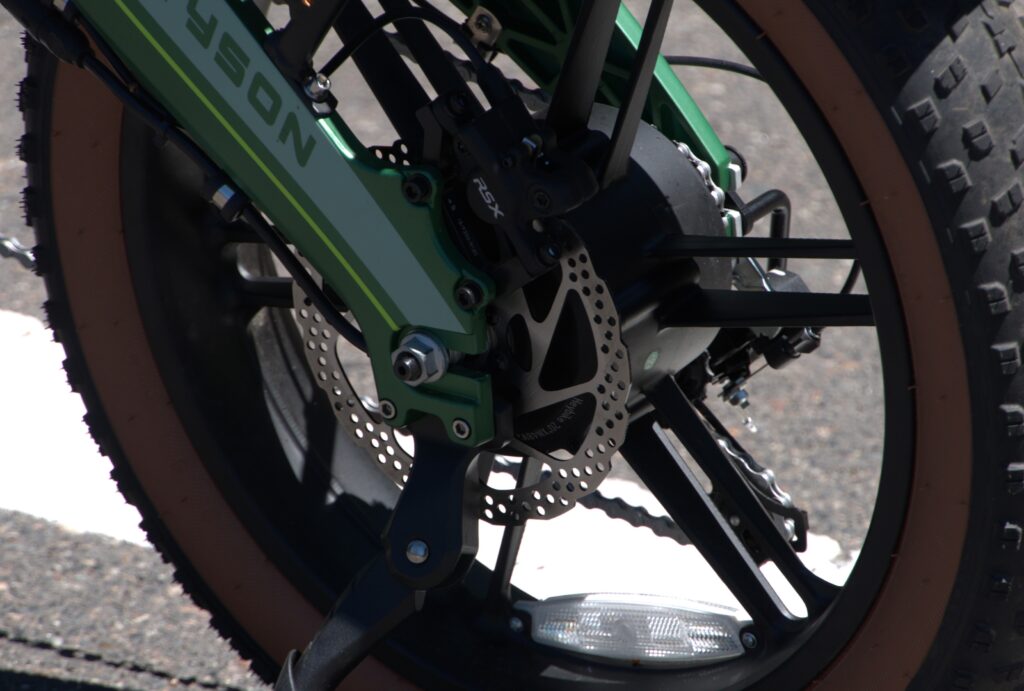
At no point did it feel like the Tyson was out of control, but it was certainly getting close to its realistic limits of high-speed handling over rough pavement. I should note that an audible whir came from the rear hub motor as the Tyson hustled down the pavement. However, it was pretty much drowned out by wind noise above 20 mph, let alone at 28 mph.
Suspension Performance
In the saddle of the Tyson, all is bliss as the full suspension system soaks up slight pavement irregularities and tempers larger bumps. There’s not much travel in the suspension, although you don’t really need it on a fat-tire e-bike. The Tyson still has enough travel to make for a calm, comfortable ride at pretty much any reasonable speed.
During my test ride, I headed onto some well-used dirt trails, and the rougher ground truly put the suspension to the test. Standing on the pedals is the best move in these circumstances. The Tyson’s folding handlebars have a good deal of rise and make standover riding easy and fun, especially when using the throttle instead of pedal power.
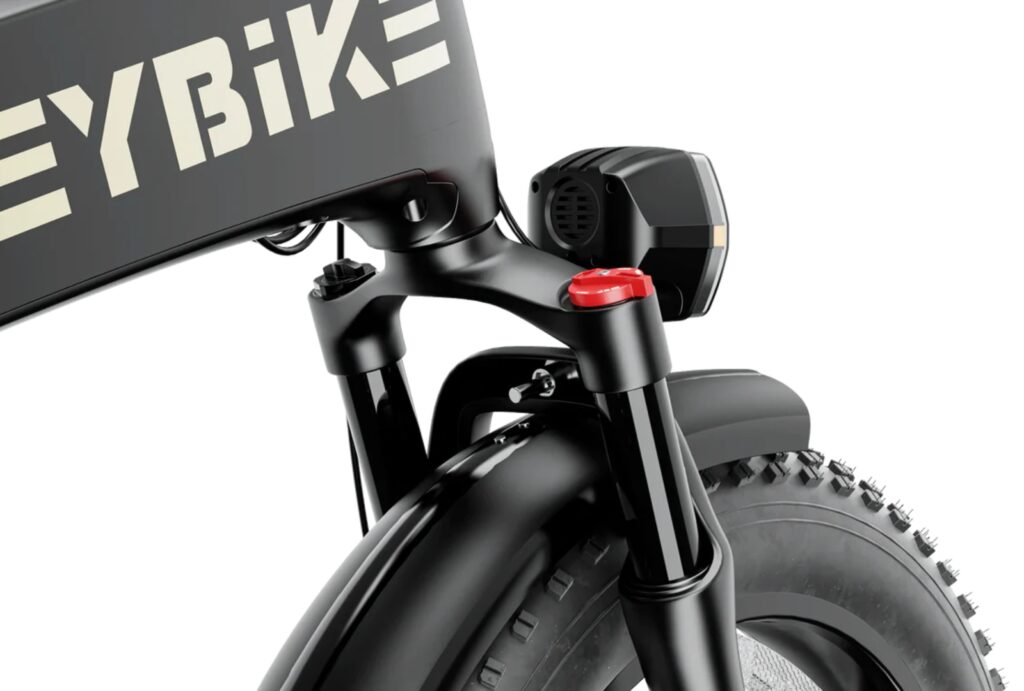
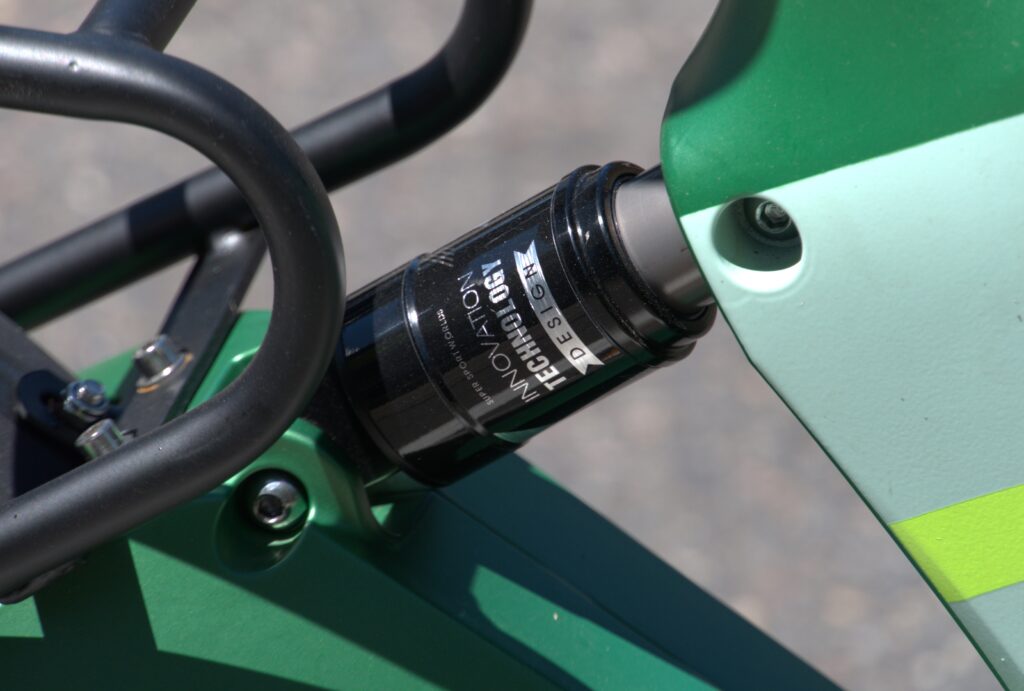
With that approach, riders can ride a bit more aggressively over rough surfaces. The front fork is underdamped (a typical shortcoming at this price point), and if the front wheel leaves the ground after cresting a berm or bump, the fork quickly extends to its limit with a noticeable thump.
Again, this is not unusual, especially since the Heybike Tyson is not a dedicated off-road exploration bike. However, the Tyson’s knobby tires and full suspension do beg a bit to go play away from the pavement. A bit more damping in the fork, or at least some measure to keep it from banging into its travel limit at full extension, would be welcome.
All that said, the full suspension bits make for a very comfortable ride on city streets, gravel roads, and dirt paths.
Lights, Safety, and Accessories
The Tyson comes with pretty much everything you need for most riding scenarios, including fenders, lighting, and a stout rear rack. What warrants some discussion, though, are the lights.
Heading home in the late evening, I activated the Tyson’s LED lights. The headlight encasement houses the small LED light, the horn/buzzer, front turn signals, and some branding. It’s more of a traffic marker than a serious tool for forward illumination.

However, the taillight is plenty bright. Thanks to the unusual rear geometry and two-tone paint scheme, it gets a lot of looks from passersby.
Unfortunately, both front and rear LED light housings feel thin and breakable compared to some others I’ve seen. The front unit sits mounted to the front shock’s brace with the same single nut/bolt/washer system that’s been in use since what seems like the 1950s. It’s too easy to knock it out of position, in my opinion. No matter how much I tightened the lone nut, it never seemed properly cinched.
This headlight attachment issue is not exclusive to Heybike. In fact, I’ve only seen Aventon properly figure out the OEM LED headlight and mount formula. It’s long past time for e-bike makers to design and implement a better system for today’s LED headlights, if you ask me.
Now, I appreciate that Heybike built turn signals into the Tyson’s light nacelles, but they’re too dim to be effective during the day. Although they show up much better at night, they’re still far from DOT-spec indicators.
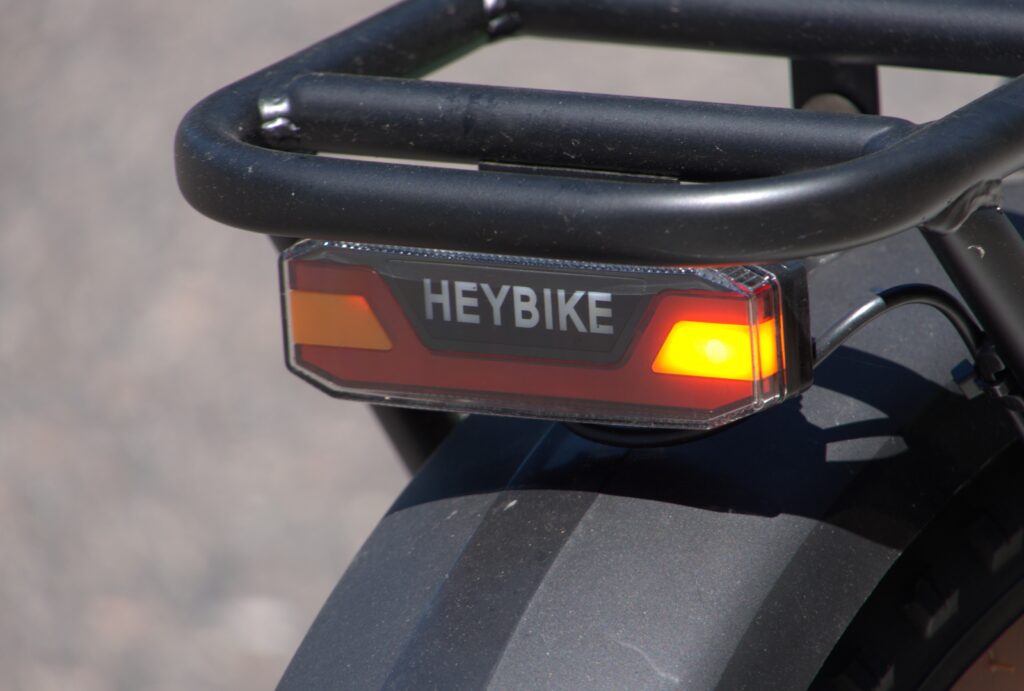
They also don’t self-cancel when activated. The single indicator in the LCD display is easy to miss, so the turn sign just keeps blinking away if unnoticed. It’s better than nothing, to be sure, but there’s some room for improvement — especially with other turn signals that automatically switch off available on the market.
I didn’t use the signals much as I’m still not habituated to using them on a bicycle like I am on a motorcycle, so they weren’t a massive issue. But here’s the bottom line: It’s nice to the lights and turn signals on the Tyson, but they could be better — especially if you plan to use the bike for commuting.
Folding Convenience and Adaptability

To try out the Tyson’s portability when folded and adaptability on urban streets, I loaded it and my partner’s magnesium-framed folding e-bike into the back of our SUV and headed downtown.
The Tyson was in its element. It made quick work of tight turns, smoothing out abrupt surface changes and threading through crowded thoroughfares. I even added some light panniers to carry some picnic bits.
We swapped bikes at one point, and my partner enjoyed the Tyson just as much as I did. After experiencing the much more comfortable (and powerful) Tyson, she was reluctant to return to her hardtail foldie.
Our trip proved the Tyson is both adaptable and portable. While it isn’t lightweight, having the ability to transport the foldable Tyson without a bike rack remains a great convenience — not just for days on the town but also for regular commutes.
Take my typical commute, for example. It’s about 10 mi each way, but I can abbreviate my riding portion by taking the city’s trains. Even though these trains have dedicated bicycle transport spaces, the Tyson’s foldability still offers some preferred transportability and maneuverability.
Hill Climb Test
My standard hill test is a nearly mile-long climb up a paved road with a grade of up to 8% in places. Overall, the Tyson acquitted itself well, keeping speeds above 10 mph.
Approaching the incline, I ticked the motor assist to Level 1 and dropped the derailleur to the lowest gear. Pedaling with average effort, I could keep the speed at or just above ten mph on an 8% grade (although I did have to click up a gear or two at some points). The motor strained under the weight and gravity’s pull, but it reached the top of my 800’ elevation gain hill test without complaint.
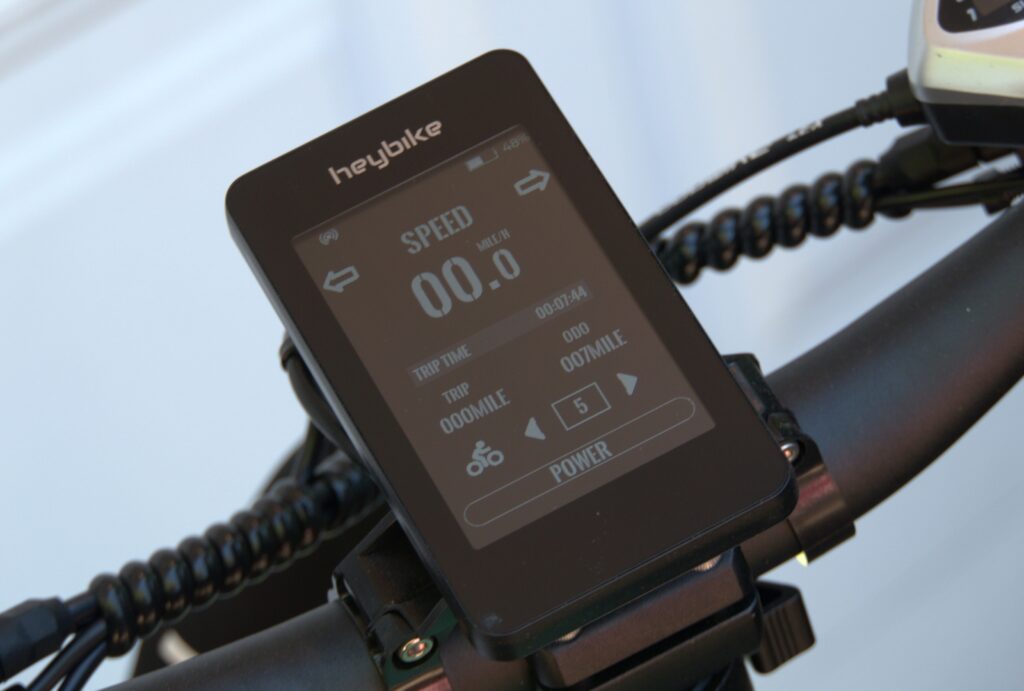
I set the assist to Level Zero for the blast back down the grade, and the Tyson tracked nicely until I got into a broad corner well above 30 mph. Brushing up against 40 mph on the pockmarked and well-worn pavement is asking a lot from a folding bike with 20” wheels and knobby tires.
At no point did it feel like the Tyson was out of control, but it was certainly getting close to its realistic limits of high-speed handling over rough pavement. The smaller wheels and underdamped suspension struggled to keep in contact with the asphalt as I traversed some rough, creased pavement.
Standing on the pedals, I eased on the rear brake to settle the Tyson. As speeds tempered, the bike regained composure.
Safely at the bottom of the hill, I set assist at Level 5 and headed back up the grade, this time at a brisker pace, closer to 15 mph in most sections.
| Attempt # | PAS Level | Average Speed |
|---|---|---|
| Attempt 1 | 1 | 10 mph |
| Attempt 2 | 5 | 14 mph |
Brake Test
Thankfully, mechanical disc brakes are almost extinct on most e-bikes. Manufacturers now favor hydraulic types like the RSX system on the Tyson, which consists of 180 mm rotors and single-puck calipers front and rear. These brakes work as expected, have good power and feel, and are easy to modulate.
I didn’t attempt a panic stop on my trial ride. However, on a long downhill at speeds above 30 mph, I laid into the brakes with a bit of gusto, and the Tyson came to a controlled stop in short order with no fade or squeal. For everyday riding, the brakes are more than adequate.
Range Test
Heybike says the 720 Wh battery in the Tyson’s frame provides 55 mi of range at the most, likely at the lowest assist setting while pedaling on a flat surface. While I never ran the battery to zero, it did get it down to single digits on one long ride.
While you might not get the full 55 mi out of the Tyson, it’s definitely capable of traveling over 35 mi on one charge. Whether climbing long hills, traversing city streets at 28 mph, rolling on throttle alone, or commuting, you can expect a decent range.
Things to Consider
The first thing to consider is that, at 77 lbs, the Tyson isn’t very light. Nor is it especially small, measuring 38.2” x 36.2” x 24.4” when folded. For larger riders like myself, that might just be a good thing. It’s comfortable, powerful, and fun to ride, all without feeling delicate like some other folding e-bikes.
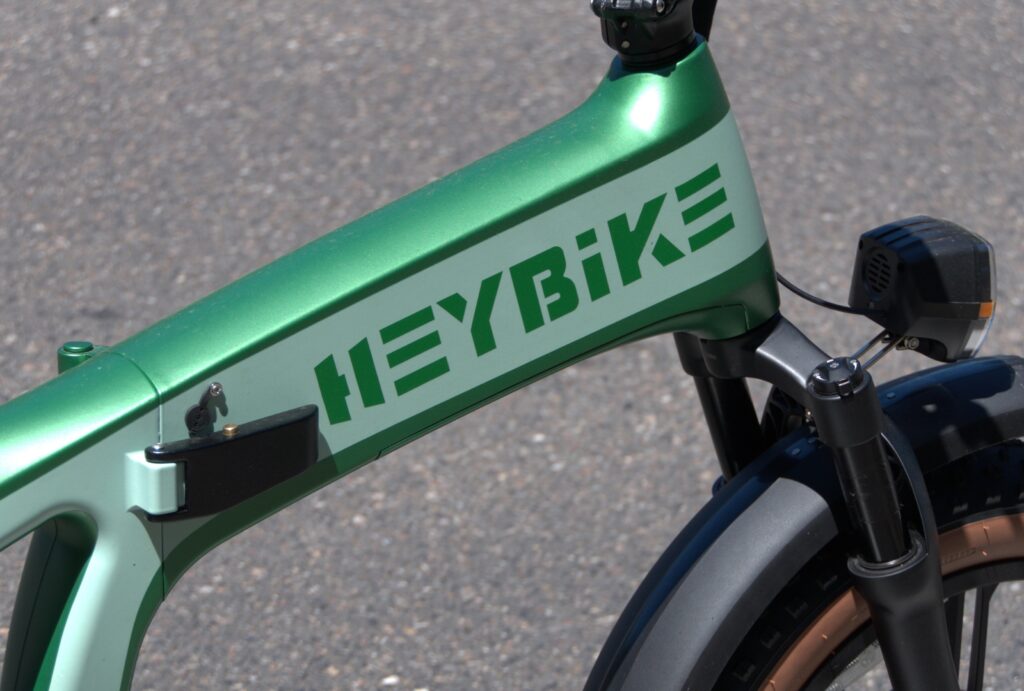
You might also consider the accessories. Despite the full complement of LED lights, commuters should probably invest in a better headlight if they have to ride down dark, unlit streets. And remember to check if your turn signal is on.
Finally, I couldn’t help but notice the extensive branding on the bike. It’s a bit over-the-top for my liking, but not a dealbreaker by any means.

